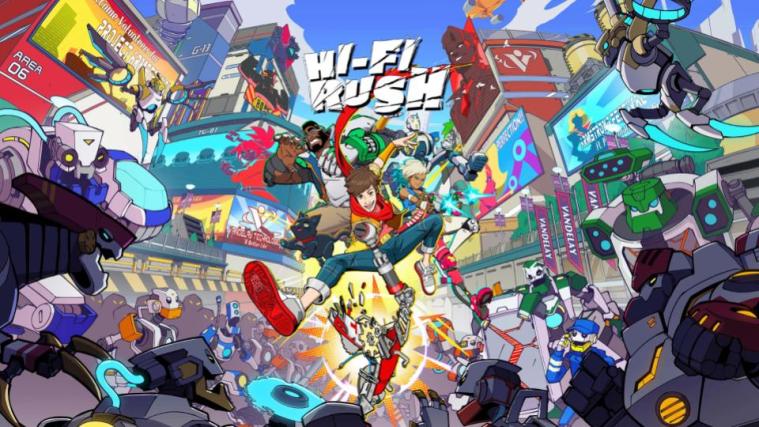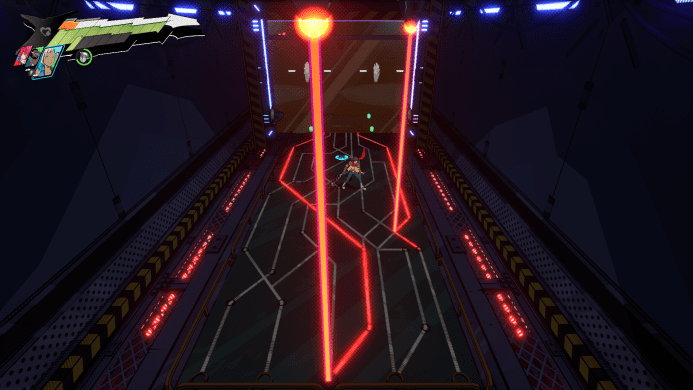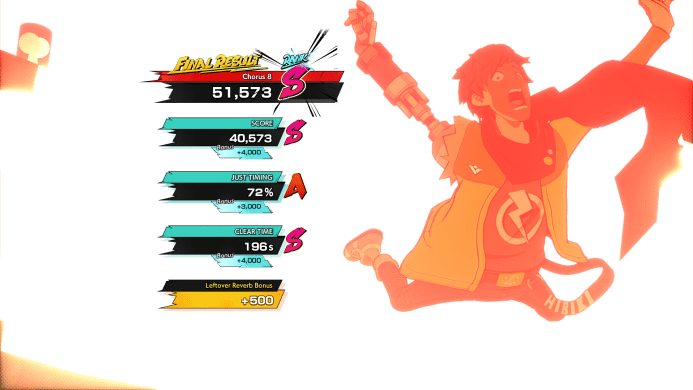I genuinely didn’t think I’d be playing all that many brand-new games this year, but then again literally nobody saw this one coming out either. Dead in the middle of a third-party publisher’s update direct, a studio known for its horror outings shadow-drops a bright and colorful character action game heavily themed around rhythm mechanics? The sheer whiplash of this game going from secretly in development to out in the wild combined with the artistic direction that was made for me was just too much for me to not check out! Let’s talk about 2023’s first big gaming surprise.

Developed by Tango Gameworks, published by Bethesda Softworks, and released on January 25th of 2023, Hi-Fi Rush is a character-action-platformer-rhythm hybrid game available on PC and Xbox Series X. Its premise involves a rock-and-roll fanatic augmented with the power of music exploring the campus of an evil megacorporation and busting countless robots with the help of his friends to uncover the dark secrets behind local operations. Players interact with the game through character-action combat and 3D platforming exploration synced to music at all times, as well as some upgrading and customizing. I played the Steam version of the game for this review.
The story of Hi-Fi Rush takes place in a near-future cartoon world on Vandelay Island and follows the story of Chai, a nobody kid with a surpassing love of rock music. Chai signs up for a cybernetics initiative called Project Armstrong and quickly finds himself outfitted with a robotic arm, but a mishandling of his personal effects leads to his not-iPod being fastened within the power source. This causes him to perceive the entire world in time to the beat of the music and lets him magnify nearby metallic waste into an electric guitar to beat stuff up with (just roll with it), but unfortunately this gets him marked as a defect by the Vandelay staff for “recall”. Chai manages to escape from Quality Assurance with the help of an underground operative named Peppermint, and Chai agrees to investigate rumors regarding Project Armstrong in return for safe passage off the island.
Obviously this all leads to a much greater conspiracy surrounding Vandelay Technologies and more characters become relevant as the story progresses, but that covers all the basics you need to know. The setting of Hi-Fi Rush grounds it primarily in the cyberpunk genre, meaning that it contains thematic elements of said genre’s specialties like technology that advances faster than ethics can regulate and the dangerous logical conclusions of unregulated consumerism. However the main genre that the story ultimately decides to write itself around is comedy, which makes for a fairly interesting mixture but in the end one that I feel leaves more things on the table than I would like. The main cast of characters get enough development that it’s hard not to like them by the end of the game, but they are written just irritating enough to facilitate a lot of “Chai is dumb” jokes for a great portion of the early game, and the party dynamics don’t really take off for me until the final main character joins up (she balances things out a lot). There are also some small things that I found a little bit hard to swallow like how the main bosses (usually) get killed off outright at the end of their battles, which not only robs us of more time to see their comeuppance sink in but also makes light of the fact that they are dead and gone, which isn’t a kind of humor I find particularly tasteful.
I’d still say the story of Hi-Fi Rush is overall pretty good however, and this is because the extra reading material absolutely carries this narrative. By interacting with various tablets and computers during your journey you can read through various company emails exchanged between players high and low at Vandelay, and this is where the game’s best writing is at. Lots of silly, exaggerated riffs on the inner workings of corporations made for a bunch of chuckles out of me, and they also flesh out the bosses to compensate for their lower screen time. There was even one notepad wherein a ‘bitter’ employee makes a certain ‘hardware update’ across the company that gets refenced more than once in the main story! When this notepad actually became a minor recurring gag, I felt so rewarded for taking the time to pay attention. Of course considering that some players will miss this content I do wonder if giving the narrative too much credit in this regard would be a problem. The main story itself actually lacks a lot of the cyberpunk bite this material has (again because we need to be constantly reminded that Chai is dumb), especially since the game’s resolution gives of a sense of marching towards a brighter tomorrow without much in the way of addressing the fundamental criticisms that form the bedrock of these types of stories. So in summary I’d say the game’s story is alright if you mostly stick to the stuff everyone sees, and better than I expected when including the legwork of the extra reading material. Nothing revolutionary, but then again action games don’t typically make revolutionary efforts on their plots anyways so I’ll take the wins I can get.
Gameplay wise, Hi-Fi Rush is a character action game in the vein of titles like Devil May Cry where the core loop is about moving between various arenas and defeating groups of enemies which demand different answers from the player. The game starts relatively simple with Chai being able to perform light and heavy attacks on the ground and in the air, but it doesn’t take too long before he’s calling in allies to break contextual shields and extend combos, or closing in on enemies with a magnetic grappling hook. What makes the game unique is that every single attack you and your enemies perform happens at a 4:4 time signature, and inputting your commands along to this beat leads to more points and greater damage. If you’ve played Crypt of the Necrodancer, you can imagine it as being roughly the same mechanic. For those not especially gifted at keeping time the game offers lots of persistent environmental and UI cues to help them play better, but on the whole this central mechanic is where the true learning curve of the game lies. Enemies in this game aren’t too terribly tricky or punishing even on higher difficulties, but failing to keep your rhythm will lower your efficiency and give your enemies more of a chance to curbstomp you anyways. While part of me wishes the combat could have been more varied by switching time signatures, I do realize that this would have had heavy strain on the timing elements that already exist in the design space, plus the game does offer a few more interesting rhythm challenges through quick-time events and later parrying sequences.
I’d also like to give Hi-Fi Rush some credit for its difficulty system, as the game communicates the expectations it is going to place upon the player extremely clearly. For pretty much every review I make you can comfortably assume I play on Normal, but this was a game I chose to play on Hard because the description better matched what I felt the game’s intended vision was, and I had a much more satisfying experience for it. Normal mode mostly just expects you to learn the beat, but Hard also expects a level of technical mastery of action combat, and I definitely recommend playing the game this way unless you want a more casual experience. I certainly feel it helped me appreciate the game’s varied enemy types and learn their patterns way more, even if most of them were pretty simple to begin with.
The combat is supported by a rather extensive upgrade system where the gears you collect throughout the game can be used to unlock new combos and sub-mechanics for Chai and Co.’s repertoire, as well as a variety of permanent upgrades and fighting-game-esque super moves. While you can eventually buy everything from this shop, gears are just limited enough that every purchase you make is a commitment, and thus one really has to consider what investments will help them most as the game progresses. Most of my money went into buying new combo routes so I could play with more attacks and rack up points, to the degree where I got all of Chai’s moves in time for the finale, but part of that scenario was my willingness to buy only the health-restoring super move and committing to using my reverb gauge near-exclusively as a damage sponge. It’s as playstyle-defining as it sounds, and that’s exactly what a good upgrade system should do.
Hi-Fi Rush links the various combat encounters together with some light 3-D platforming which occasionally shifts into 2-D. Though actions are not chained to the music as much in these sections per se, most of the obstacles still move on the beat so the consistency of the rhythm element ties the two major halves of the game together. And when I say “move on the beat”, I mean it. Platforms and elevators which in other games you would stand around on for a few seconds snap between their important locations in perfect 4:4, making the act of navigation both more involved and more convenient than most of its contemporaries. The levels themselves have lots of hidden upgrade items and all-important datapads strewn about them, as well as some humorous NPC robots to talk to, so there’s a lot of worthwhile rewards for exploring each section of Vandelay Island thoroughly. On the whole, this game takes a variety of simple game mechanics and unites them to its core idea to make each one greater than the sum of its parts, and it’s quite satisfying to play. You may feel a bit limited at first, but before long when you’re blazing through levels in time to the music and feeling the rush of landing a combo with a tangible sense of crescendo, any complaints about the game’s simplicity seem petty by comparison.

As for Hi-Fi Rush’s presentation, quite frankly I’m not entirely sure what I can even say about it which watching a gameplay video won’t make it abundantly clear. The industry finally seems to be collectively learning a thing or two from Guilty Gear Xrd (which I consider to be the golden standard of graphical style), because this game is nothing short of a playable comic book with the added flair of a music video. The various locations of Chai’s journey are full of bright colors and cheeky environment design, and every character is animated incredibly expressively. Perhaps something I can speak about which most people may not immediately notice is just how effective the character design is more broadly. The most apparent thought here is how the cybernetics do a lot of legwork in communicating the levels of crazy a character is, as for the most part characters with low amounts of augmentation give off a sense of warmth which is completely lost from those immersed in it. But there are also a lot of really simple details which feel most poignant. The fact that Chai’s device of choice is an old school iPod looking thing as opposed to something like his phone, which has all but replaced the former in a practical sense, does a lot to communicate just how much he loves music. The game’s first boss Rekka wears a massive golden belt with her name on it to invoke a wrestler’s motif, but the very standard business wear that dominates her appearance compared to some of the later bosses gives off a sense of hard-working loyalty and pride which not every boss shares with her. Just about every aspect of the graphics in Hi-Fi Rush has its best foot forward, and while not completely free of its more budget elements nonetheless comes off with a confidence that cannot be understated.
And of course there is Hi-Fi Rush’s music, an element critical to the very identity of the game as a whole. The game draws upon rock music styles of modernity to craft its levels’ backing tracks, and there are plenty of fun pieces that play throughout the adventure. The music of Chapter 11 sticks out in particular for me, but others such as Chapters 5 through 7 were just as memorable. It did not escape me however that some of the game’s music does occasionally suffer from being a little underscored, and while I understand this compensates for the musical sound effects that play when you’re landing combos it does cause some of the soundtrack to lose energy when it should be doing anything but. Ultimately though I really respected the dedication to the theme which the soundtrack leans into, and it’s as much fun to listen to in game as it is outside of it.
One final major note about the music is that Hi-Fi Rush actually managed to pick up some licensed rock music to play during some scenes, mostly the boss fights, however realizing this would cause problems for streamers the developers smartly included a full suite of original compositions which not only replace the licensed music but are also written to match their particular tones. For example the first boss of the game is set to the song 1,000,000 by Nine Inch Nails and the second jams to Free Radicals by The Flaming Lips, however with streamer mode turned on you get the songs Too Big to Fail and Captive Normals respectively played by The Glass Pyramids (which I assume is some kind of pseudonym but don’t quote me on that). At the risk of being a bit controversial, I actually recommend playing with the streamer mode turned on as not only do I think it’s cool that the original music pays homage to the songs they are replacing, but being composed specifically for the game gives them a certain artistic cohesion to the action on screen (though this is not to discredit playing with the licensed music either, both are perfectly valid ways of experiencing the game). Maybe if you’re a big fan of modern rock music you could play the game once with the original scores and try to guess who they’re tributing, then play the game again and see what bands show up?
As for what we can take away spiritually from Hi-Fi Rush, the comedic tone definitely undercuts much of what could be gleaned from the game explicitly, however there are some elements that when observed more symbolically reveal a rather interesting message about mankind’s misguided need for total control. If that which we call medicine is designed by mankind to help the body return to its natural function, Project Armstrong and similar technology in other stories represent man trying to reach beyond natural limits and conform his body to his own image of what man should be. Vandelay Industries in particular takes this to an extreme by actively using the project to decide the destiny of those participating, as despite putting ‘rockstar’ on his application the algorithm running the surgery deems Chai only worthy of being outfitted for garbage removal. Yet though Chai may not be a musician by any stretch, Providence seemed fit to work through that declared identity anyways by planting that music player in Chai’s chest, assuming we interpret ‘rock’ as motion or change and ‘star’ as being a paragon, making Chai a paragon of change. In this way we can easily see echoes of the way God uses the lowly to humble the mighty through the events of the game, albeit with a little interpretation on my part. To those of us in power I would warn of believing too much that the world is ours to shape when God holds the universe itself in His care, and to those of us without power I would speak of courage in The Lord who may yet guide your steps to a great calling, if you rise to the summons. Just… please don’t sign up for crazy transhuman cybernetics experiments, it’s against Church law.

In conclusion, Hi-Fi Rush is one of the most wild new games to come out recently, but its incredible sense of style is well justified by gameplay that’s as satisfying as it is unique. There may be some elements of the game that I wish were a bit tighter and in truth I really wouldn’t recommend it to people who aren’t cognizant of the ethical discussions surrounding the technology in cyberpunk settings, but otherwise I felt it was well worth my time. Almost everything about this game feels like it should have been made a decade ago when games were more at liberty to be their own thing rather than meet corporate demands and chase trends, but perhaps it’s because those times are behind us which makes Hi-Fi Rush such a noteworthy success. Time will tell if this surprise tour will rock the gaming world, but for now I’m happy for it to rock my speakers.
Scoring: 90%
Gameplay: 5/5
Story: 4/5
Art and Graphics: 5/5
Music: 4/5
Replayability: 5/5
Morality/Parental Warnings
Hi-Fi Rush is a rhythm action game which takes place in a cartoon world rooted in cyberpunk tropes. While the comedic tone of the setting lends the game to a more family friendly audience, I do think it has knock on effects which make the ethically questionable technology look more appealing than it should. The player also explicitly kills off most of the major bosses, and while it’s not graphic and definitely cartoony they definitely stick out in a game where you fight robots the entire rest of the time. Some of the women in the game wear clothing that shows a fair amount of skin, though as far as I could tell there wasn’t anything too scandalous, and you can unlock the ability to switch their outfits through endgame achievements. Foul language does appear in the game, but it’s not as frequent as most other titles and less strong overall. The tutorial tips robot you can optionally talk to speaks in tones of innuendo, and while Chai calls him out on it there’s a sense of the game having its cake and eating it too.
